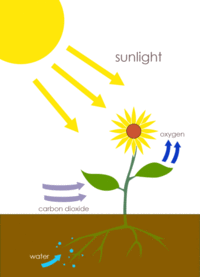Some science for the gardener
- This is Section 3 of the Gardening Seminar:Start your own garden. Comments or questions are appreciated. You can also write to John Eagles.
[[|320px|thumb|right|]]
This chapter is necessarily a bit more complex. I still advise you to spend some time studying these topics as this content is important for many processes of growth in your garden. Understanding the scientific explanation helps you to make the right decisions regarding the plants you grow, how you manage the soil and what fertilizers you need.
Photosynthesis
- Main article: Photosynthesis
All green plants can be seen as little factories that produce energy and food for all other living beings. The basic elements they need for this are water, air and sunlight. The process that runs in these countless factories is called 'photosynthesis.'
Photosynthesis takes place in a green pigment in plants, so-called chlorophyll, which absorbs sunlight. Plants are green because plants cannot absorb the green light that comes from the sun, though they absorb blue and red light. The green light is reflected back and makes the plant appear green.
Photosynthesis is the process by which green plants and some other organisms use sunlight to synthesize foods from carbon dioxide and water. It is the magical process that makes all our gardening and farming worthwhile. Air (carbondioxide) and water and sunlight are transformed into energy (sugar) and the structural element (carbon) for cells and oxygen to breathe.
Many plants survive in low light conditions. But when a plant is denied enough light, it attempts to grow taller in order to find light. The plant is taller but also weaker.
Photosynthesis is vital for all life on Earth that needs oxygen.
- Photosynthesis maintains normal levels of oxygen in the atmosphere
- It is the source of energy for building up the cells of an organism in which photosynthesis occurs, or as a source of food, it gives this energy to other organisms. For example, humans and animals eat plants.
Nitrogen cycle
- Main article: Nitrogen cycle
The diagram to the right shows how nitrogen gas that is present in the atmosphere goes into a cycle that makes nitrogen available to plants.
- Nitrogen from the air is fixed by bacteria that live as nodules on roots of legumes[1] and some other plant species. These nitrogen-fixing bacteria give nitrogen to the plants on which they live, and when these plants die, the nitrogen remains in the soil.
- Nitrogen from the air is fixed by nitrogen-fixing soil bacteria. They transform nitrogen to ammonium (NH4+). This process is called ammonification[2].
- Animals drop manure into the soil. Animals and plants die and animal waste and dead animals and plants are decomposed by aerobic and anaerobic fungi and bacteria. Also through this process, ammonium (NH4+) is formed.
- Nitrifying bacteria transform ammonium (NH4+) first into nitrites (NO2-) and then into nitrates (NO3-) in a process called nitrification[3].
- Plants can assimilate nitrates (NO3-). Nitrates are also affected by denitrifying bacteria that bring nitrogen gas back into the atmosphere in a process called denitrification[4].
Some practical implications
Plants need nitrogen for their growth. A main component of fertilizers is nitrogen in a form that plants can take in. One way to improve your soil is by adding compost that contains enough nitrogen. Another method is to grow legumes (for example peas and beans, and a few other plant species, not legumes) that form root nodules with nitrogen-fixing bacteria. Yet another method is to sow fast growing plants only for the improvement of your soil. These plants are called 'green manure' plants. Some examples of green manure plants are phacelia, rye and mustard but there are many more. Yet another method is to cover the soil with a layer of decomposing plants, in the form of hay or straw or any other plants. This method is called mulching. These plants are decomposed and enrich the soil with humus-forming components and also with nitrogen.
To enable a speedy process of ammonification and nitrification in your soil, your soil should not only be rich of compost or decomposing plant materials, but should also contain enough oxygen, as most micro-organisms and also animals such as rain worms that decompose these materials need oxygen.
pH
- Main article: PH
Back
- Gardening Seminar:Start your own garden to go to the other sections of this seminar.
- Designing your garden to go to the former section of this seminar
Next section
- [[]]
See also
- a
References
- ↑ Legumes - Wikipedia "A legume is a plant in the family Fabaceae (or Leguminosae), or a fruit of these specific plants."
- ↑ Ammonification - Wikipedia "When a plant or animal dies, or an animal expels waste, the initial form of nitrogen is organic. Bacteria, or fungi in some cases, convert the organic nitrogen within the remains back into ammonium (NH4+), a process called ammonification or mineralization."
- ↑ Nitrification - Wikipedia "Nitrification is the biological oxidation of ammonia with oxygen into nitrite followed by the oxidation of these nitrites into nitrates."
- ↑ Denitrification - Wikipedia "Denitrification is a microbially facilitated process of nitrate reduction that may ultimately produce molecular nitrogen (N2) through a series of intermediate gaseous nitrogen oxide products."
External links
Comments
- Coming soon


